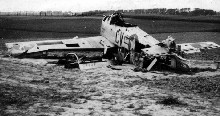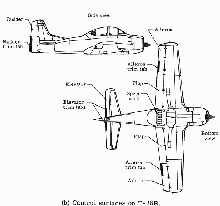BACK
|
 |
Obviously, this
plane was piloted by an aviator that did not receive my training.
|
 |
Control surfaces
on a T-28B
|
|
| Lesson One:
The Element of Surprise |
In the vast majority of all kills, the defender is
unaware of the presence of the attacker until it is too late. Once
in an advantageous position, even the least skilled pilot can
bring down an ace. Gaining this advantage requires a complete
understanding of the environment in which the pilot stalks his
prey. The position of the sun, cloud cover, and angle of attack
are vital elements of a successful strike on the unwary adversary.
Tips for success:
- Appraise the situation before launching an attack. This
involves observing the flight path and altitude of the target
and environmental factors affecting both attacker and
defender.
- Attempt to maneuver to an angle of attack with the sun
behind you or from which the target cannot see your approach.
- Once in position to attack, patiently approach until within
300 feet of the target. Slow your aircraft to prevent
overshooting the target. Do not fire your weapons using the
"Spray and Pray" technique. This will only make the
target aware of your presence and waste ammunition.
- When you maneuver your aircraft within 150 feet and match
the speed of the target, reappraise the target's flight path.
Determine any angle of deflection required to hit the target.
This is otherwise known as leading the target.
- Fire in short bursts. Do not fire continuously as this will
decrease your ability to manipulate the aircraft controls and
waste ammunition.
BACK
|
|

